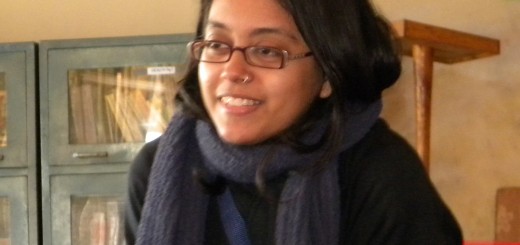Cut It!
After having shot your documentary, what comes next? You need to concatenate the appropriate scenes one after the other for the collection of scenes to make sense visually and intellectually. In other words, you need to edit your film. With this very intention in mind, the next workshop that was conducted by the Department of Electronic Media and Mass Communication (DEMMC) was that of editing. This workshop was facilitated by Pankaj Rishi Kumar, an alumni of the editing school of the Film and Television Institute of India (FTII, Pune) and was co facilitated by Radhika Khanna, Editor The Inquirer and Asst. Professor DEMMC, Pondicherry University.
Pankaj Rishi Kumar visited the university on 12 and 13 September, 2013. He spent two evenings with the students who had participated in the documentary workshop with Ajay Raina. His focus, rather than the content of filmmaking, was on how the material of the film was presented in order to make it a rich representation of the subject.
He began by demonstrating the Kuleshov effect – an effect demonstrated by Russian filmmaker Lev Kuleshov in the 1910s and 1920s. In this effect a single shot is juxtaposed with several different shots to give a different perspective and meaning with every new juxtaposition. Instead of using Kuleshov’s images from Tsarian Russia however, Pankaj Rishi Kumar used images of his own. He allowed the students to speak their minds and elaborate as to what each pairing signifies to each of them. After the entire exercise he elucidates that this little exercise is an oversimplified form of what is known as ‘editing.’
Cut and paste, he said, the procedure the students are experts in since time immemorial, is also the basic requirement for film editing. You just need to take some shots, place it somewhere it makes sense, do the same with the audio, and slowly the film will be completed. He also discussed about the aesthetic sense in which the shots should be placed to make the film a better one.
Another important lesson Pankaj gave the students during his workshop is that he dissociated the idea of truth and the content of a documentary. Documentary is not something that shows the truth, the whole truth and nothing but the truth. The truth is given a much more presentable manner in order to make the film presentable. In other words, the truth is also ‘edited.’ Pankaj Rishi Kumar also emphasized on the importance of research which is a vital tool for documentary filmmaking.
Pankaj Rishi Kumar congratulated every team on the work they showed but left with the advice of how to improve on each one of them and hoping to see more of the work of the students. The workshop was co-facilitated by academy guide Radhika Khanna.
Tathagata Mitra
1st M.A. Mass Communication


